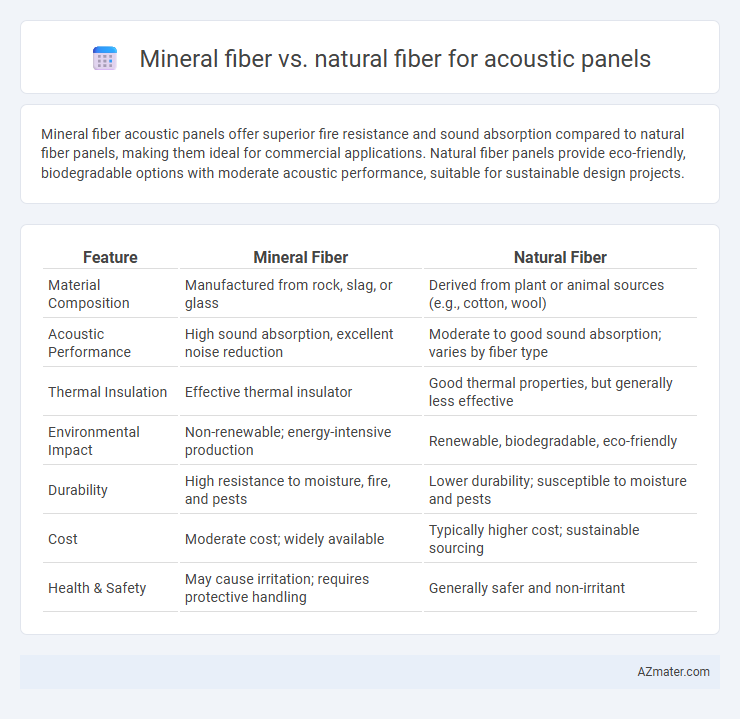Mineral fiber acoustic panels offer superior fire resistance and sound absorption compared to natural fiber panels, making them ideal for commercial applications. Natural fiber panels provide eco-friendly, biodegradable options with moderate acoustic performance, suitable for sustainable design projects.
Table of Comparison
| Feature | Mineral Fiber | Natural Fiber |
|---|---|---|
| Material Composition | Manufactured from rock, slag, or glass | Derived from plant or animal sources (e.g., cotton, wool) |
| Acoustic Performance | High sound absorption, excellent noise reduction | Moderate to good sound absorption; varies by fiber type |
| Thermal Insulation | Effective thermal insulator | Good thermal properties, but generally less effective |
| Environmental Impact | Non-renewable; energy-intensive production | Renewable, biodegradable, eco-friendly |
| Durability | High resistance to moisture, fire, and pests | Lower durability; susceptible to moisture and pests |
| Cost | Moderate cost; widely available | Typically higher cost; sustainable sourcing |
| Health & Safety | May cause irritation; requires protective handling | Generally safer and non-irritant |
Introduction to Acoustic Panel Materials
Mineral fiber and natural fiber are two common acoustic panel materials used for sound absorption and noise control. Mineral fibers, such as fiberglass and rock wool, offer high density and fire resistance, making them ideal for industrial and commercial acoustic treatments. Natural fibers like cotton, hemp, and wool provide eco-friendly, sustainable alternatives with effective sound absorption properties, often preferred in residential and environmentally conscious designs.
Overview of Mineral Fiber Acoustic Panels
Mineral fiber acoustic panels are engineered from inorganic materials like rock wool or glass wool, offering superior sound absorption and fire resistance compared to natural fibers. These panels provide high-density sound dampening, excellent thermal insulation, and enhanced durability in commercial and industrial environments. Their resistance to moisture and mold makes mineral fiber panels a reliable choice for long-term acoustic performance in diverse settings.
Overview of Natural Fiber Acoustic Panels
Natural fiber acoustic panels utilize materials such as cotton, hemp, and jute, providing sustainable and eco-friendly sound absorption solutions. These panels offer excellent thermal insulation properties alongside effective noise reduction by trapping and dissipating sound waves through their porous structures. Compared to mineral fiber panels, natural fibers are biodegradable, non-toxic, and contribute to healthier indoor air quality, making them ideal for environmentally conscious acoustic treatment.
Sound Absorption Properties: Mineral vs. Natural Fiber
Mineral fibers, such as glass wool or rock wool, exhibit superior sound absorption properties due to their dense, non-porous structure, which effectively traps and dissipates sound waves across a broad frequency range. Natural fibers like cotton or sheep wool provide sound absorption through their porous and fibrous matrix but generally deliver lower sound attenuation levels, especially at low frequencies. The enhanced acoustic performance of mineral fibers makes them the preferred choice for high-efficiency acoustic panels in environments requiring stringent noise control.
Environmental Impact and Sustainability
Mineral fiber acoustic panels, often made from recycled slag or glass, exhibit moderate environmental impact due to energy-intensive manufacturing but offer durability and fire resistance, extending product lifespan. Natural fiber panels, commonly sourced from materials like hemp, wool, or cotton, boast low embodied energy and biodegradability, significantly reducing landfill waste and carbon emissions during production. Choosing natural fibers supports renewable resource cycles and promotes healthier indoor air quality through low chemical emissions, enhancing overall sustainability in acoustic panel applications.
Fire Resistance and Safety Comparison
Mineral fiber acoustic panels, typically made from basalt or slag wool, offer superior fire resistance with high melting points around 1000degC, making them highly effective in preventing the spread of flames. Natural fiber panels, composed of materials such as cotton, hemp, or wool, generally have lower fire resistance and may require chemical treatments to meet safety standards. For applications prioritizing fire safety, mineral fiber panels present a more reliable option due to their inherent non-combustible properties and compliance with stringent building codes.
Durability and Longevity
Mineral fiber acoustic panels exhibit superior durability and longevity compared to natural fiber alternatives due to their resistance to moisture, fire, and microbial growth. Natural fiber panels, while environmentally friendly, tend to degrade faster in humid or high-traffic environments, leading to a shorter lifespan. Choosing mineral fiber ensures sustained acoustic performance and reduced maintenance over time.
Installation and Maintenance Differences
Mineral fiber acoustic panels, typically made from glass or rock wool, require protective gloves and masks during installation due to fiber irritation risks, whereas natural fiber panels like cotton or hemp offer safer, more user-friendly handling. Maintenance for mineral fiber panels involves careful cleaning to avoid fiber release and potential health hazards, while natural fibers generally allow easier cleaning with less risk of airborne particles. Both types provide effective sound absorption, but natural fiber panels often present a more sustainable and low-maintenance option in commercial and residential acoustic treatments.
Cost Analysis: Mineral Fiber vs. Natural Fiber
Mineral fiber acoustic panels typically offer lower upfront costs due to mass production and widespread availability, making them a cost-effective choice for large projects. Natural fiber panels, such as those made from wool or cotton, tend to have higher material and manufacturing costs, but offer improved sustainability and biodegradability. Long-term cost analysis should include factors like durability, maintenance, and environmental impact, where natural fibers may provide better value despite a higher initial investment.
Choosing the Right Acoustic Panel for Your Space
Mineral fiber acoustic panels offer superior sound absorption and fire resistance, making them ideal for commercial spaces requiring strict safety codes. Natural fiber panels, such as those made from wool or cotton, provide eco-friendly, renewable options with excellent thermal insulation properties and a softer acoustic profile. Selecting the right panel depends on balancing performance needs, budget constraints, and environmental considerations specific to your space.

Infographic: Mineral fiber vs Natural fiber for Acoustic panel
 azmater.com
azmater.com